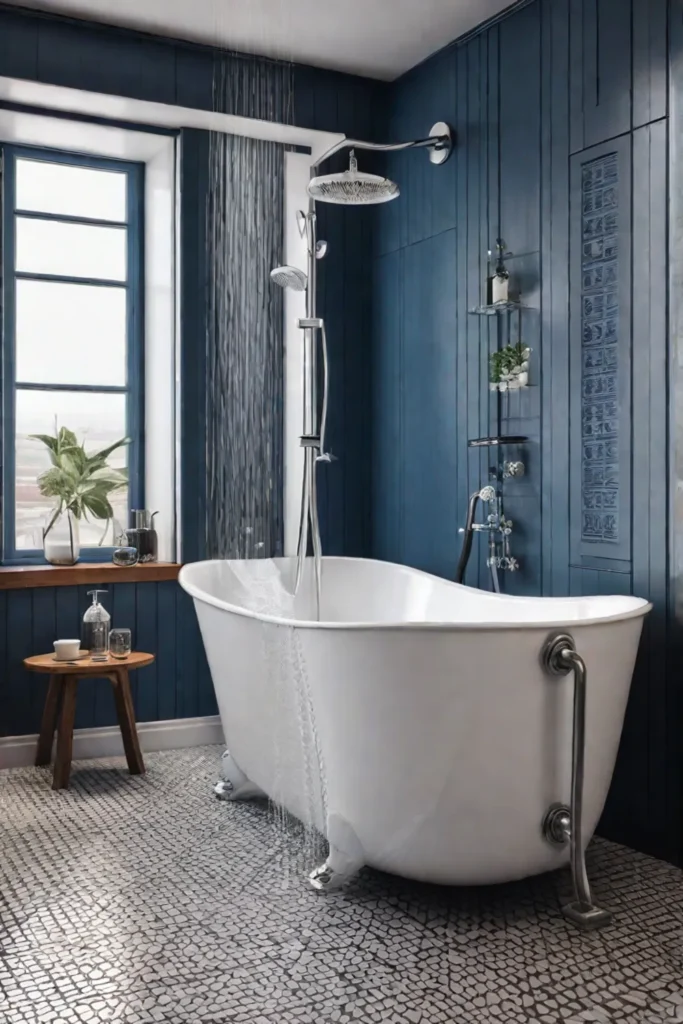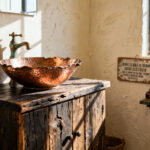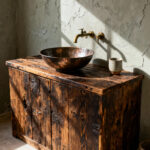Designing a small bathroom can be a real challenge – you want it to be stylish and functional but, most importantly, safe. As an esteemed interior designer based in Philadelphia, I know firsthand how unique the safety considerations are for compact bathroom spaces. Bathrooms are actually one of the most common rooms in the home for accidents and injuries, with factors like limited space, moisture, and slippery surfaces creating unique hazards.
However, following some essential safety tips and smart design choices, you can transform your small bathroom into a beautiful and secure haven. In this article, we’ll explore key ways to prioritize safety without sacrificing style, covering everything from proper lighting and electrical safeguards to slip-resistant flooring and accessible storage solutions. Whether you’re renovating an older home or designing a new small bathroom from scratch, these tips will help ensure your space is both functional and safe for all who use it.

Lighting and Electrical Safety
Proper lighting is absolutely crucial for a safe and accessible small bathroom. Inadequate illumination can create dark corners and shadowy areas where accidents are more likely to occur. That’s why it’s so important to ensure you have adequate task lighting, especially around the sink area where grooming tasks are performed.
To achieve this, consider installing recessed lighting along the perimeter of the ceiling. This will provide even, glare-free illumination throughout the space. You’ll also want to add vanity lighting above the mirror to eliminate harsh shadows. And don’t forget about nightlights – strategically placed near the toilet or shower, they can make nighttime navigation a breeze.

Beyond lighting, electrical safety is paramount in small bathrooms. These wet environments are one of the most common spots for electrical accidents in the home. To prevent shocks and short circuits, be sure to use moisture-resistant light fixtures and properly ground all electrical components. Motion-activated lights are another great option, as they conserve energy and enhance safety by automatically turning on when someone enters the room.
Flooring and Slip Prevention
Slips and falls are a major concern in small bathrooms, so choosing the right flooring material is essential. Textured tiles, non-slip mats, and floor grips can all provide excellent traction to prevent accidents, especially when the floor is wet.
When it comes to traction, the key is ensuring the surface has enough grip to keep you steady on your feet. Smooth tiles or natural stone can become dangerously slippery, so opt for materials with a low water absorption rate and good slip resistance. Porcelain tiles and cork flooring are two great options that offer both style and safety.

Proper floor drainage is another important consideration. Designing the bathroom floor with a gentle slope towards the drain helps water flow away efficiently, reducing the risk of pooling and potential slip hazards. Linear drain systems or shower pans with built-in drains are excellent solutions for small bathrooms.
Storage and Organization
Small bathrooms often struggle with storage, but the way you organize your space can have a big impact on safety. Cluttered, overflowing bathrooms increase the chances of tripping and falling, not to mention posing potential fire hazards from exposed electrical cords.
Maximize storage with wall-mounted shelves, recessed medicine cabinets, and drawer organizers to keep your small bathroom tidy and secure. This helps ensure frequently used items are within easy reach without creating obstacles. It’s also crucial to store any breakable or hazardous items, like cleaning supplies or medications, in high, locked cabinets that are out of reach of curious little hands.

Remember, good storage and organization don’t just make your small bathroom look neat and stylish – they also play a key role in maintaining a safe environment for all users.
Accessibility and Mobility
As an interior designer, I’m particularly passionate about creating spaces that are accessible and inclusive for people of all abilities. This is especially important in small bathrooms, where mobility can be limited.
Wheelchair-accessible design is a must, with features like widened doorways, curbless showers, and roll-in shower areas. Strategically placed grab bars near the toilet, tub, and shower also provide crucial support and stability for those who need it.
But accessibility goes beyond just accommodating wheelchairs. It’s also about ensuring fixtures and surfaces are easy to reach and navigate. Adjustable-height sinks, lowered countertops, and towel bars positioned at accessible heights make a big difference in creating a safe, small bathroom for everyone.

By prioritizing these accessibility and mobility features, you can transform your small bathroom into a space that’s not only beautiful but also inclusive and secure.
Water Safety and Ventilation
Water can pose some serious safety risks in small bathrooms, from scalding hot temperatures to dangerous mold and mildew growth. That’s why it’s so important to focus on water management and proper ventilation.
Start by installing thermostatic shower valves and anti-scald faucets to regulate water temperature and prevent accidental burns, especially for households with young children or elderly residents. Proper drainage and moisture control are also key – make sure your small bathroom floor is sloped towards the drain, and utilize exhaust fans or dehumidifiers to keep humidity levels in check.

Choosing moisture-resistant materials like porcelain tiles or vinyl flooring is another smart way to ward off mold and mildew. These surfaces not only look great, but they’re much easier to keep clean and dry, creating a safer, healthier small bathroom environment.
Emergency Preparedness
While we all hope emergencies never happen, it’s crucial to be prepared, especially in a small bathroom where accidents can occur more easily. Keep a well-stocked first aid kit on hand, complete with bandages, antiseptic wipes, and other essential medical supplies.
It’s also a good idea to install a waterproof phone or emergency call button near the shower or bathtub so you can quickly summon help if needed. And don’t forget about lighting – battery-powered LED lights can provide crucial illumination during power outages or other emergencies.

Finally, plan your small bathroom’s evacuation route carefully, ensuring all paths are clear and unobstructed. This will allow for a quick and safe exit in the event of a fire or other crisis.
Supervision and Safety Practices
When it comes to small bathroom safety, supervision and established practices are just as important as design features. This is especially true if you have young children in the home.
Always supervise children when they’re using the bathroom, and install child-proof locks on doors and cabinets to restrict access to hazardous areas and items. Teach kids proper bathroom hygiene and safety habits, like not running around, turning off faucets tightly, and avoiding unsupervised water play.
Secure storage for cleaning products, medications, and other potentially dangerous items is also crucial. Use high, locked cabinets that little hands can’t reach to keep these hazards out of harm’s way.

By implementing these supervision and safety protocols, you can create a small bathroom environment that’s beautiful and incredibly secure for the whole family.
Maintenance and Ongoing Safety
Maintaining a safe, small bathroom environment requires ongoing vigilance and attention to detail. Regular inspections, prompt repairs, and a keen eye for potential hazards are essential.
Be sure to conduct routine safety checks, looking for issues like loose tiles, damaged grout, or leaky faucets. Please address any problems you find right away to prevent them from becoming bigger, more dangerous concerns. Always stay alert for potential hazards, like wet floors or exposed electrical wiring, so you can take immediate action to mitigate risks.
Proper maintenance keeps your small bathroom looking its best and ensures it remains a secure, functional haven for years to come. By prioritizing these proactive measures, you can enjoy your stylish small bathroom with complete peace of mind.

Conclusion
Designing a safe and beautiful small bathroom may seem daunting, but by following these essential tips, you can create a space that’s both visually stunning and incredibly secure. From proper lighting and slip-resistant flooring to accessible storage and emergency preparedness, each element plays a crucial role in keeping your small bathroom a haven of comfort and safety.
As an experienced interior designer, I know firsthand the unique challenges of small bathroom design. But by focusing on the safety considerations outlined in this article, you can transform even the most compact space into a functional, stylish, and – most importantly – safe retreat for you and your family. So don’t be afraid to get creative and put these tips into practice – your small bathroom will thank you!






